Past Year Questions: Highway Materials | Transportation Engineering - Civil Engineering (CE) PDF Download
Q1: Which one of the following statements related to bitumen is FALSE? [2024, Set-1]
(a) Kinematic Viscosity is a measure of resistance to the flow of molten bitumen under gravity
(b) Softer grade bitumen possesses higher softening point than hard grade bitumen.
(c) Flash point of bitumen is the lowest temperature at which application of a test flame causes vapors of the bitumen to catch an instant fire in the form of flash under specified test conditions.
(d) Ductility test is carried out on bitumen to test its adhesive property and ability to stretch
Ans: (b)
Q1: Consider the Marshall method of mix design for bituminous mix. With the increase in bitumen content, which of the following statements is/are TRUE? [2023, Set2]
(a) the Stability decreases initially and then increases
(b) the Flow increases monotonically
(c) the air voids (VA) increases initially and then decreases
(d) the voids filled with bitumen (VFB) increases monotonically
Ans: (b, d)
Sol: For marshall mix design, following graphical results are obtained.
⇒ Stability increases initially and then decreases
Hence option (A) is INCORRECT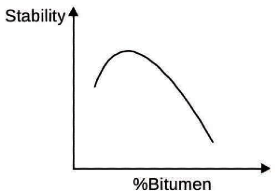
⇒ Flow increases monotonically
Hence option (B) is CORRECT
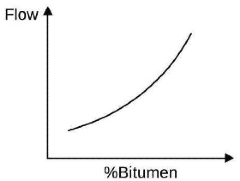
⇒ Air voids decreases continously
Hence option (C) is INCORRECT
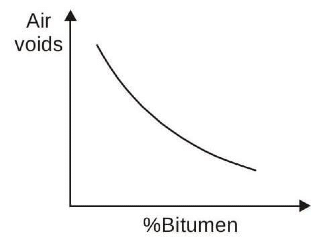
⇒ VFB increases monotonically
Hence option (D) is CORRECT
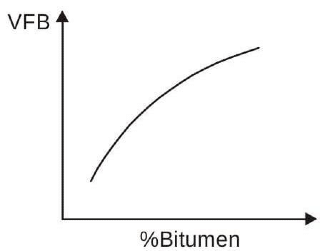
Q1: The softening point of bitumen has the same unit as that of [2021, Set-2]
(a) distance
(b) temperature
(c) time
(d) viscosity
Ans: (b)
Sol: Softening point is the temperature at which bitumen becomes soft and starts flowing.
Q1: Group-I gives a list of test methods for evaluating properties of aggregates. Group-II gives the list of properties to be evaluated. [2020, Set-2]
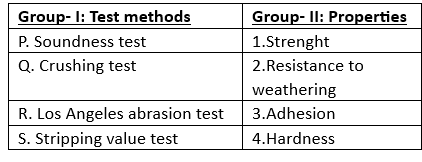
The correct match of test methods under Group-I to properties under Group-II, is
(a) P-4, Q-1, R-2, S-3
(b) P-2, Q-1, R-4, S-3
(c) P-3, Q-4, R-1, S-2
(d) P-2, Q-4, R-3, S-1
Ans: (b)
Sol: Soundness test is done to evaluate resistance against weathering of aggregate.
Crushing test is done to evaluate strength of aggregate.
Los angles abrasion test is to evaluate hardness of aggregate.
Stripping value test is to evaluate ratio of uncovered area observed to the total area of aggregate. The test is conducted to determine the effects of moisture upon the adhesion of binding material.
Q2: The Los Angeles test for stone aggregates is used to examine [2020, Set-1]
(a) abrasion resistance
(b) crushing strength
(c) soundness
(d) specific gravity
Ans: (a)
Sol: Los Angles abrasion test is carried out to examine the hardness i.e., abrasion resistance property of aggregate
Q1: Structural failures considered in the mechanistic method of bituminous pavement design are [2019, Set-2]
(a) Fatigue and Rutting
(b) Fatigue and Shear
(c) Rutting and Shear
(d) Shear and Slippage
Ans: (a)
Question 1. If the fineness modulus of a sample of fine aggregates is 4.3, the mean size of the particles in the sample is between [2019 : 1 Mark, Set-II]
(a) 300 μm and 600 μm
(b) 2.36 mm and 4.75 mm
(c) 1.18 mm and 2.36 mm
(d) 150 μm and 300 μm
Answer: (c)
Solution: The sieves that are to be used for the sieve analysis of the aggregate (coarse, fine, or all- in-aggregate) for concrete as per IS:2386 (Part-1) -1963 are, 80 mm, 40 mm, 20 mm, 10 mm, 4.75 mm, 2.36 mm, 1.18 mm, 600 μm, 300 μm and 150 μm.
The fineness modulus can be regarded as a weighted average size of a sieve on which material is retained and the sieves being counted from the first sieve.
Fineness modulus of 4.3 indicates size between 4th and 5th sieve i.e., between 1.18 mm and 2.36 mm.
Question 2.The initial concavity in the Load-penetration curve of a CBR test is NOT due to [2018 : 1 Mark, Set-II]
(a) uneven top surface
(b) high impact at start of loading
(c) inclined penetration plunger
(d) soft top layer of soaked soil
Answer: (b)
Solution:
Initial concavity in CBR test is due to :
• Improper compaction
• Soft top layer
• Inclined plunger
• Uneven top serface
Question 3. A bitumen sample has been graded as VG30 as per IS: 73-2013. The ‘30’ in the grade means that [2018 : 1 Mark, Set-I]
(a) penetration of bitumen at 25°C is between 20 and 40
(b) viscosity of bitumen at 60°C is between 2400 and 3600 Poise
(c) ductility of bitumen at 27°C is more than 30 cm
(d) elastic recovery of bitumen at 15°C is more than 30%
Answer: (b)
Question 4. The following observations are made while testing aggregate for its suitability in pavement construction:
(i) Mass of oven-dry aggregate in air = 1000g
(ii) Mass of saturated surface-dry aggregate in air = 1025 g
(iii) Mass of saturated surface-dry aggregate underwater = 625 g Based on the above observations, the correct statement is [2017 : 2 Marks, Set-I]
(a) bulk specific gravity of aggregate = 2.5 and water absorption = 2.5%
(b) bulk specific gravity of aggregate = 2.5 and water absorption = 2.4%
(c) apparent specific gravity of aggregate = 2.5 and water absorption = 2.5% (d) apparent specific gravity of aggregate = 2.5 and water absorption = 2.4%
Answer: (a)
Solution:
Where,
A = Mass of oven dry aggregate in air
B = Mass of Saturated surface dry aggregate in air
C = Mass of Saturated surface dry aggregate underwater
Question 5. During a forensic investigation of pavement failure, an engineer reconstructed the graphs P, Q, R and S, using partial and damaged old reports. 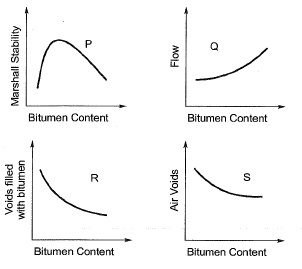
Theoretically plausible correct graphs according to the ' Marshall mixture design output’ are [2016 : 1 Mark, Set-I]
(a) P, Q, R
(b) P, Q, S
(c) Q, R, S
(d) R, S, P
Answer: (b)
Solution: The graph between VFB and Bitumen content is,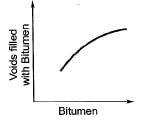
Question 6. Match the information related to test on aggregates given in Group-I with that in Group-ll. [2015 : 2 Marks, Set-II]
Group-I
P. Resistance to impact
Q. Resistance to wear
R. Resistance to weathering action
S. Resistance to crushing
Group-ll
1. Hardness
2. Strength
3. Toughness
4. Soundness
(a) P-1, Q-3, R-4, S-2
(b) P-3, Q-1, R-4, S-2
(c) P-4, Q-1, R-3, S-2
(d) P-3, Q-4, R-2, S-1
Answer: (b)
Question 7. In Marshall method of mix design, the coarse aggregate, fine aggregate, fines and bitumen having respective values of specific gravity 2.60, 2.70, 2.65 and 1.01, are mixed in the relative proportions (% by weight) of 55.0, 35.8, 3.7 and 5.5 respectively. The theoretical specific gravity of the mix and the effective specific gravity of the aggregates in the mix respectively are [2015 : 2 Marks, Set-II]
(a) 2.42 and 2.63
(b) 2.42 and 2.78
(c) 2.42 and 2.93
(d) 2.64 and 2.78
Answer: (a)
Solution:

Effective specific gravity of aggregates (coarse + fine) is given by,
Question 8. The penetration value of a bitumen sample tested at 25°C is 80. When this sample is heated to 60°C and tested again, the needle of the penetration test apparatus penetrates the bitumen sample by d mm. The value of d CANNOT be less than _________ mm. [2015 : 1 Mark, Set-I]
Solution: Relationship between penetration and temperature is given by,
P= AT+ K
Where P = Penetration
A = Temperature susceptibility
K= Constant
With in crease in temperature , penetration increases.
Hence, we will simply take,
Question 9. In a Marshall sample, the bulk specific gravity of mix and aggregates are 2.324 and 2.546 respectively. The sample includes 5% of bitumen (by total weight of mix) of specific gravity 1.10. The theoretical maximum specific gravity of mix is 2.441. The void filled with bitumen (VFB) in the Marshall sample (in %) i s ______ . [2014 : 2 Marks, Set-II]
Solution: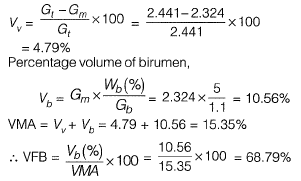
Question 10. In compacted cylindrical bituminous mix
VMA = 15% (void mineral aggregate)
Vv = 4.5% (air void) The magnitude of VFB (void filled bituminous) is [2013 : 2 Marks]
(a) 24
(b) 30
(c) 54
(d) 70
Answer : (d)
Solution: 
Question 11. Two bitumen samples “A" and “ V” have softening points 45°C and 60°C, respectively. Consider the following statement:
I. Viscosity of “X” will be higher than that of “ V” at the same temperature.
II. Penetration value of “X ’ will be lesser than that of “ Y' under standard conditions.
The CORRECT option evaluating the above statements is [2012 : 1 Mark]
(a) Both I and II are TRUE
(b) I is FALSE and II is TRUE
(c) Both I and II are FALSE
(d) I is TRUE and II is FALSE
Answer: (c)
Solution: Since softening point for Vis higher than X.
∴ Viscosity of Vis high as compared to Xand penetration will be more in X, because it will offer less resistance to penetrate.
∴ Both statement I & II are false.
Question 12. In Marshall testing of bituminous mixes, as the bitumen content increases the flow value [2011 : 1 Mark]
(a) remains constant
(b) decreases first and then increases
(c) increases monotonically
(d) increases first and then decreases
Answer: (c)
Solution: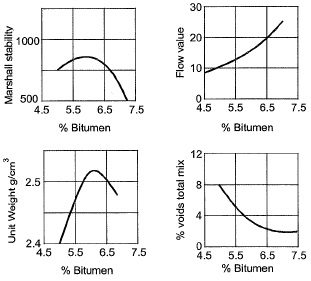
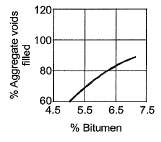
Question 13. Aggregate impact value indicates which one of the following property of aggregates? [2010 : 1 Mark]
(a) Durability
(b) Toughness
(c) Hardness
(d) Strength
Answer: (b)
|
27 videos|118 docs|58 tests
|
FAQs on Past Year Questions: Highway Materials - Transportation Engineering - Civil Engineering (CE)
| 1. What are the main types of materials used in highway construction? |  |
| 2. How is the quality of highway materials tested? |  |
| 3. What role do aggregates play in highway materials? |  |
| 4. Why is the selection of highway materials important? |  |
| 5. What are the environmental considerations in selecting highway materials? |  |
















